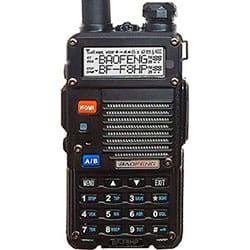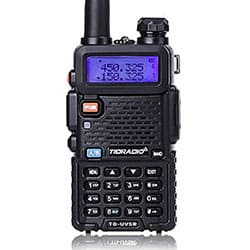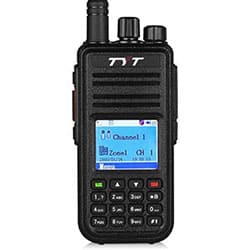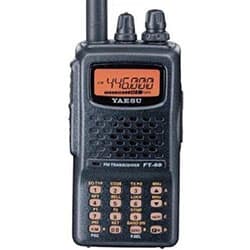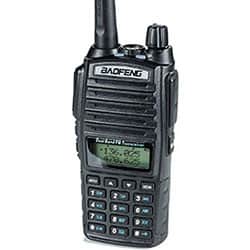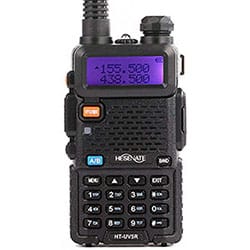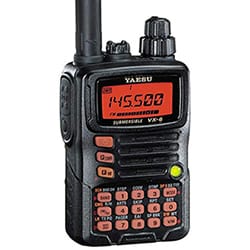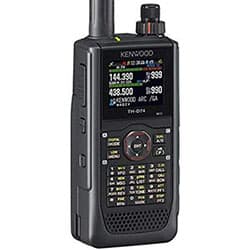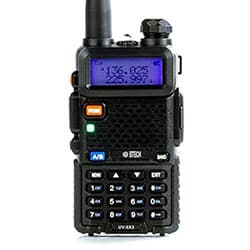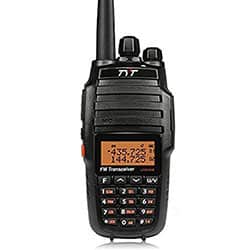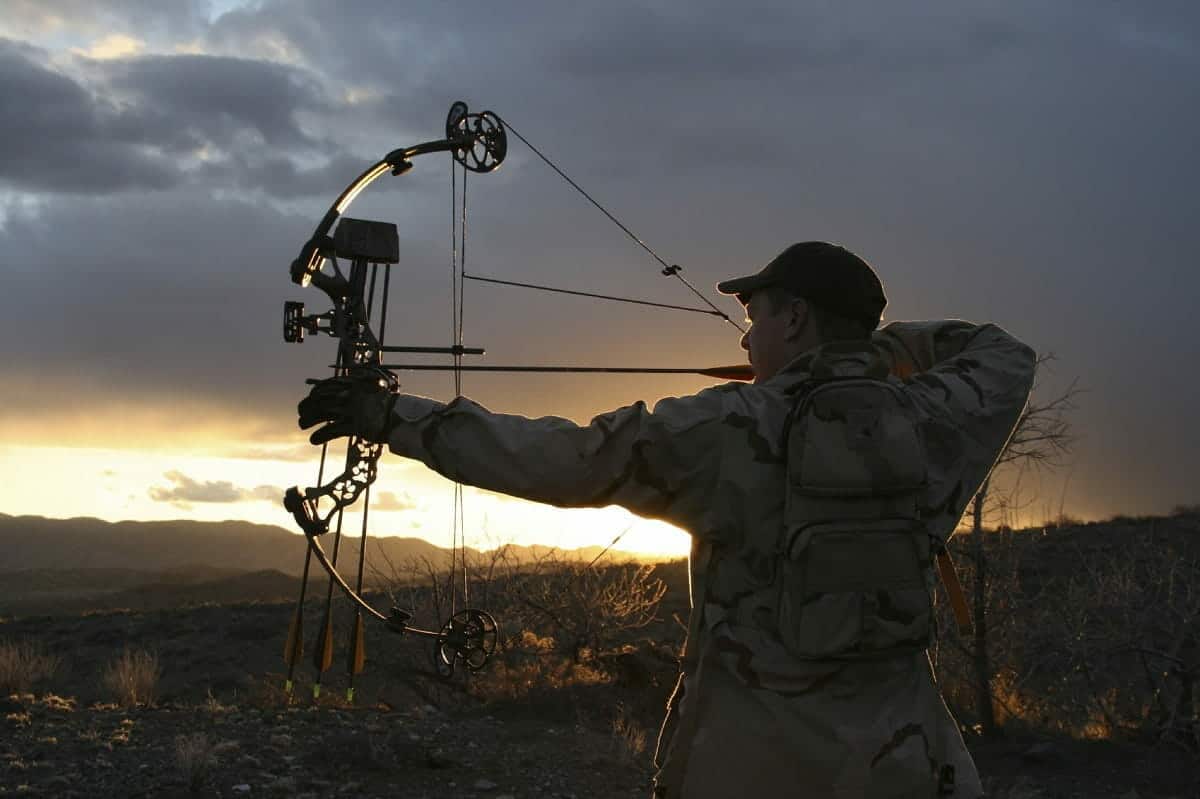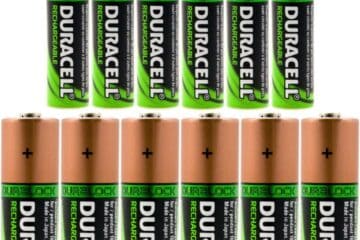Here in the digital age, where children carry around more computing power in their pocket than was used to send men to the moon, it’s easy to lose track of older forms of communication. Bookstores are on life support, newspapers aren’t far behind and ham radio seems about as relevant as the rotary phone. But where other forms of communication have succumbed to the digital onslaught ham radio endures.
Why? Because when a natural disaster leaves the local digital infrastructure in tatters ham radios are there to pick up the slack. Handheld ham radios, while not as powerful as the one that takes up half your neighbor’s attic, can be just as useful in an emergency and are just a boatload of fun besides. Below are the 10 best handheld ham radios for 2021.
1. BaoFeng BF-F8HP 8-Watt Ham Radio
There’s no escaping BaoFeng in the handheld radio world. And that’s fine because they make some extraordinary products. The BF-F8HP is an 8 watt handheld ham that provides you with that extra power you need to send your signal over hill and dale. The high gain antenna also assists mightily in this respect.
But BaoFeng didn’t just ramp up the transmitting power of this handhand ham, they also increased battery power by 30% to accommodate it’s increased energy needs. You actually have 3 power settings (1, 4 and 8 watts), but most people want this device for those extra watts you just can’t get on most other handheld ham radios. Comes with a comprehensive user guide in English and robust support.
2. Tidradio TD-UV5R
The TD-UV5R is a versatile, dependable, surprisingly powerful little ham radio. It’s feature-rich, charges quickly, provides about 10 hours of use on a full charge and is PC programmable. Use it to communicate during an emergency, listen to music, stay in touch with others on the family camping trip or just to talk with other hams late into the night.
With its high gain antenna it has an unusually long reach for a 5 watt radio and with the 15 inch 771 Antenna you can extend that range even farther. The scan function allows you to find others and open communication. And the integrated LED flashlight allows you to find your way when the lights go out. You also have the option of setting and storing frequencies for easy retrieval. Finally, programming the TD-UV5R is relatively easy either through the keyboard or by connecting it to your computer.
3. TYT MD-380 TRBO Ham Radio
The TYT MD-380 TRBO Ham Radio uses DMR technology to produce crystal clear audio quality across multiple bands. It features a full color display (rare for this type of radio), let’s you switch between an analog or digital signal and, (in digital mode), can be used to send text messages. That can be very handy in an emergency.
The menu system is intuitive and easy enough to understand. And if you take this puppy into the backcountry you don’t have to worry about rain or snow as it’s highly water resistant. Comes with everything you need to get started including a desktop charger, belt clip, programming cable and a pair of antennas to extend its already formidable range.
4. Yaesu FT-60R Dual Band Handheld 5W VHF
With a thousand memory channels and 3 power settings the Yaesu FT-60R is a great all-purpose ham radio. Battery life is impressive, the cast aluminum body is extremely tough and the 5 watts of power is in line with more expensive, high-end handheld hams. The fact that it’s water resistant makes it a great choice for your hunting or camping trip.
There’s a low battery alarm, dual band compatibility, an illuminated keypad and multiple scan modes. It also provides NOAA weather info. The antenna that comes with it is nothing to write home about. But the FT-60R will work with a variety of aftermarket antennas. So there’s no need to endure limited reception.
5. BaoFeng UV-82HP Dual Band Ham Radio
BaoFeng is determined to conquer the handheld radio market and with products like their UV-82HP Dual Band Ham Radio they’re on their way to achieving their goal. If features 3 power settings (8, 4 and 1 watt), receives UHF and VHF and lets you lock VFO/MR via the accompanying software. There’s also an 80 page users guide that does an admirable job explaining everything.
The dual push to talk (PTT) button lets you transmit on two frequencies. The newest BaoFeng chipset provides outstanding range. And the slightly larger buttons make the radio easier to use in difficult situations than past iterations. The LCD display is not the best you’ll ever find. But the speaker is large and potent and the rugged aluminum body will take a pounding.
6. Hesenate HT-UV5R Dual Band Ham Radio
The Hesenate HT-UV5R features high and low power settings, customizable channel names as well as wide and narrow band capability. It’s one of the easier handheld ham radios to program using your PC. Although you’ll still need to refer to the user’s guide early and often.
The package includes a dual band antenna that greatly expands range, a desktop charger, belt clip and earpiece. And because it’s made by BaoFeng you can be reasonably sure it’s going to stand up to both outdoor environments and the test of time. With low battery alert, auto time out and LED flashlight it’s an affordable workhorse.
7. Yaesu VX-6R Submersible Amateur Ham Radio
The Yaesu VX-6R is a rugged, submersible handheld ham radio that’s perfect for hunters, mountaineers, rescue workers, homeowners or hobbyists. It was built with the outdoors in mind and features JIS7 waterproofing and a tough-as-nails magnesium case. It’s also compact and light so carrying it miles into the backcountry isn’t going to wear you out.
The VX-6R can be password protected, offers 900 memory channels and has a backlit, multicolor LCD screen. The lithium-ion battery is not the best in the business. But it’s not bad either. Just expected something a little better. That’s about the only real downside here. Except of course trying to program using those tiny buttons. Transmits on the 144, 220 and 430Mhz ham radio bands.
8. Kenwood Original TH-D74A Triband
Kenwood makes something of a surprise appearance on our list with their outstanding TH-D74A Triband ham radio. This is a feature-rich radio transceiver that boasts APRS for sending and receiving texts, GPS data and more. In addition, there’s an updatable repeater list, DSP voice processing, a micro USB port, IF filtering and a lot more.
That ‘lot more’ includes 1,000 programmable channels, AM/FM radio, CB stations, a 32 GB SD card and Bluetooth. The whole thing is also IP54 rated. Which means it will stand up to any weather, though you probably shouldn’t submerge it. About the only significant downside is the tiny buttons. That and the sometimes head scratching menu organization.
9. BTECH UV-5X3 5 Tri-Band Ham Radio
The BTech UV-5X3 Tri-Band Ham Radio is a compact powerhouse with on-the-fly selectable frequency range scanning and a V-85 dual band antenna that greatly extends the effective range. It’s completely backward compatible with the company’s older UV-5R model accessories and it’s very affordable to boot.
There are a bunch of innovative features including display syncing which lets you see both the frequency and name of the current channel simultaneously. There’s also VOX Busy Channel Lock-Out and alpha numeric channel storage. It’s also PC programmable or you can add and remove channels via the on-screen menus.
10. TYT UV8000E 10W Ham Radio
The last of our best handheld ham radios is this from TYT. It’s a dual band transceiver with dozens of programmable channels. There’s a cross band repeater, hands free VOX activation, backlit LCD screen and two high gain antennas that really project the signal. And that signal is riding a very stout 10 watts of power.
Audio quality is generally outstanding. The speaker doesn’t get drowned out outdoors and battery life is excellent. In addition, there’s a low battery alarm and a very informative guidebook to take you through set up and programming. (Though it should be noted that you can only program the UV8000E through your PC.) Overall an excellent choice for those who want a bit more power from their handheld ham radio.
FAQs
What is a Ham Radio?
A ham radio is one operated by an ordinary citizen as opposed to a media company or government entity. Private citizens have a right to use designated radio frequencies (1) for non-commercial purposes and a ham radio, along with CB radio, enables this type of use. People use ham radio for a variety of purposes. But it really comes into its own during emergency situations, natural disasters and the like. When ordinary channels of communication often break down.
Many people confuse ham radio with CB radio. But other than some superficial similarities such as being the domain of the ordinary citizen the two are actually quite different. Ham radio equipment can transmit at up to 1.5kW of power. Even handhelds can do 10 watts or more. While CB radio is constrained to transmitting at 5 watts. The vast majority of ham operators are licensed as well and have taken courses in basic radio operation and equipment. Ham radios also operate on a variety of frequency bands (2) while CB is restricted to the 27mhz band.
Why is it Called ‘Ham’ Radio?
The 600 pound gorilla in the room any time ham radio is discussed is how it got its name. If you want to really get some heated debate going just bring this up in the company of a group of ham operators. But while there are numerous urban legends circulating on the subject two explanations tend to have the most adherents.
The badge of honor version – According to this story the early days of radio were a time of chaos. Frequencies had not been allocated by the government so every station theoretically had the entire spectrum available to them. As a result everyone was stepping on everyone else’s radiowave toes all the time. Commercial operators got angry at the amatuer usurpers and began to refer to them by the derogatory term ‘ham’ (as in ‘ham actor’). Amateurs then adopted the term as a kind of badge of honor and the rest, as they say, is history.
The Harvard version – The other theory regarding the origins of the term ‘ham’ radio goes like this: HAM was an anagram of the names ‘Hyman, Almy and Murray’. They were three members of the Harvard Radio Club way back near the turn of the 20th century who had established their own wireless station. After trying several variations they settled on HAM as the call letters of their station. While cute as all get-out this version reeks of the same type of ham-fisted efforts used by the British upper crust to claim Shakespeare as their own (3). The bottom line is that the origins of the name remain shrouded in mystery and controversy.
What are the Licensing Requirements for a Ham Radio?
If you want to transmit on your new ham radio (as opposed to just listening), you will need a license. This fact scares a lot of people off who A) don’t want The Man monitoring their every move or B) just don’t want to be bothered. If you have an aversion to inviting the long arm of the government into your life you’ll likely need to be satisfied with standard walkie talkies or a CB radio. If, however, it’s the licensing process that is putting you off of ham radio you may be surprised to learn the process is actually much simpler now than it used to be (4).
There are three levels of license. The Technicians License entails answering 35 questions. If you pass you’re allowed to transmit domestically. The General License also calls for a 35 question test, but on different aspects of radio operation. Pass it and you can transmit both domestically and internationally. And finally, the Amateur Extra License which is 50 questions long. If you pass it you are allowed to operate on all bands with full operating privileges.
Do I Really Need a License? Really?
Okay, you can – from a purely technical standpoint – operate a ham radio without a license. But doing so is likely to bring the wrath of both the government (5) and other ham operators down upon you. The fine for operating without a license can run as high as $10,000. You’ll also have your equipment confiscated. And you might spend a few days in jail.
But in all honesty the government has other things to do besides tracking down radio renegades, unless of course you’re interfering with some government operation. Then they’ll be on you like stink on you-know-what. The bigger threat to your unlicensed shenanigans will be other operators who can easily determine where your signal is originating from and alert authorities. Get a license. It costs about 15 bucks and will make your life a lot easier.
What are Some Things to Consider With a Ham Radio?
Here are some common considerations for those looking into ham radio.
Power – When it comes to handheld radios you’re looking at limited amounts of power. There’s no way around that. Even ones that claim to be ‘high power’ are limited to 5 or maybe 10 watts at most. So don’t look for the 1,500 watts or more that some ham radio stations have at their disposal (6).
Frequencies – The frequency you’re allowed to transmit on will depend on the type of license you have (see above). When you buy a ham radio (handheld or otherwise) make sure it is designed to operate on the frequencies you have access to (7).
Bands – The dual band feature allows the operator to monitor two frequencies simultaneously. General coverage lets you use your allotted ham radio bands and also receive AM, FM radio and some TV frequencies. You will likely spend a lot of time on the 440 MHz band (8) allotted by the government to ham operators.
Backlight – If you plan on using your ham radio at night while camping in the woods, for instance, it’s important that the screen be backlit. Also, if you’re at home and the power goes out during a natural disaster you’re going to be glad your screen is backlit. In addition, look for the ability to toggle that backlight on and off to save power.
What are the Benefits of a Ham Radio?
People purchase ham radios for several different reasons, but mostly because:
It’s an interesting hobby – Operating a ham radio, even if it’s a relatively low-powered handheld radio, is a good hobby for those who find the likes of bird watching or stamp collecting a bit boring.
It helps expand your world – There are currently some 2 million or so ham operators worldwide (9). And while handheld ham radios are limited in power they nonetheless allow you to tune into this previously unknown segment of society. You’re bound to make new friends and expand your worldview.
They’re useful in an emergency – When the SHTF people need a reliable way to communicate. Ham radio is one of the best. Ham radio operators are often pressed into service coordinating rescues and helping steer emergency services to where they’re needed.
It doesn’t cost an arm and a leg – Beyond the initial cost of the radio itself it’s a hobby you can pursue for a lifetime at very little cost.
I have a Cellphone. Why do I Need a Ham Radio?
You don’t. Then again you don’t ‘need’ a cell phone either. People got along without them for approximately a million years. But that aside, the case for the ham radio can best be illustrated by using the example of a natural disaster. Say a hurricane slams ashore where you live. It flattens everything, strands thousands without safe water, power or food and takes down all the cell towers for a hundred miles. How exactly will you call for help on your cellphone if you can’t get a signal? The short answer is, you won’t be able to (10). If you have a ham radio, however, you’ll be able to keep in touch with other operators and even FEMA, who advocate the use of ham radio during emergencies (11).
Isn’t my Emergency Radio Good Enough?
There is nothing wrong with having an emergency radio on hand. In fact, every home should have one. But their usefulness, while real, is still limited. They simply don’t offer the type of cut-through-the-fog practicality ham radios do in emergency situations. Think about it. While an emergency radio may offer AM/FM, NOAA radio and maybe a few other informational channels many such stations stop broadcasting when things get really gnarly.
Ham radio on the other hand typically springs to life during and after a disaster. It’s not dependent on dozens of employees showing up to keep the station running. It’s not dependent on cell towers remaining upright and it can hook you up with others in your immediate area who might need your help or be able to help you.
The Bottom Line
Handheld ham radios are essential emergency gear for anyone living in a high risk area. They provide communication when cellphones, internet, TV and standard radio all go down and they enable the coordination of rescue and relief efforts. But aside from the important role they play in disaster relief they also make for a first class hobby, can provide entry into a larger world and make a great gift for the outdoor enthusiast in your family. The handheld ham radios on our list represent the cream of the crop. They’re all well-built, reliable, easy to use and affordable. Whatever it is you are looking for in a handheld ham radio you’ll find it in one of our 10 best ham radios for 2020.
